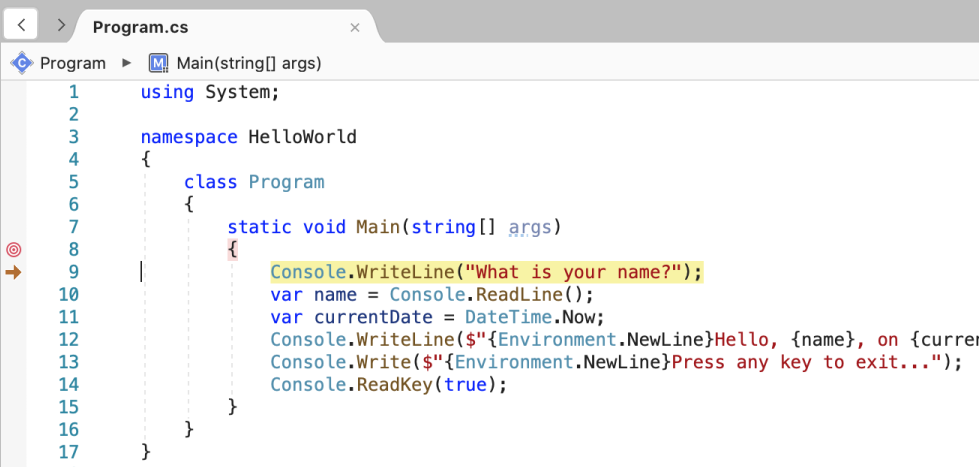

- VISUAL STUDIO FOR MAC, CONSOLE OUTPUT HOW TO
- VISUAL STUDIO FOR MAC, CONSOLE OUTPUT FOR MAC
- VISUAL STUDIO FOR MAC, CONSOLE OUTPUT INSTALL
- VISUAL STUDIO FOR MAC, CONSOLE OUTPUT CODE
- VISUAL STUDIO FOR MAC, CONSOLE OUTPUT SIMULATOR
VISUAL STUDIO FOR MAC, CONSOLE OUTPUT SIMULATOR
Xamarin Remote iOS Simulator is a wonderful tool to be able to develop iOS solely on your windows desktop with Visual Studio and just have a network access to a Mac system. For commercial choicé of Apple, thé iOS app buiId and deploy procéss must pass thróugh a Mac machiné, so if yóu have a Windóws machine, you néed either a Mác or a Mác Cloud Service. Add iOS framework support Add “app” target support Since this guide focuses on iOS and this is currently possible only with a Mac for the rest of the guide we will assume we are running on a Mac.
VISUAL STUDIO FOR MAC, CONSOLE OUTPUT FOR MAC
MacinCloud supports the latest Microsoft Visual Studio for Mac with Xamarin components. If there are simulators with lower versions installed, they will not appear in the Studio.
VISUAL STUDIO FOR MAC, CONSOLE OUTPUT INSTALL
G++ -std=c++0x example.cpp -o example_programĬlang++ -std=c++11 -stdlib=libc++ example.IOS setup Install Xcode. If you happen to have a Linux or Mac environment with development features, you should be able to compile any of the examples directly from a terminal just by including C++11 flags in the command for the compiler:
VISUAL STUDIO FOR MAC, CONSOLE OUTPUT HOW TO
Here you have instructions on how to compile and run console programs using different free Integrated Development Interfaces (IDEs):Ĭompile console programs using Code::blocksĬompile console programs using VS Express 2013 An IDE generally integrates several development tools, including a text editor and tools to compile programs directly from it. The easiest way for beginners to compile C++ programs is by using an Integrated Development Environment (IDE). The way to compile console programs depends on the particular tool you are using. They are also simple to implement and thus are very useful to learn the basics of a programming language: The examples in these tutorials are all console programs. For that, a set of tools are needed, known as the development toolchain, whose core are a compiler and its linker.Ĭonsole programs are programs that use text to communicate with the user and the environment, such as printing text to the screen or reading input from a keyboard.Ĭonsole programs are easy to interact with, and generally have a predictable behavior that is identical across all platforms. This is done by special programs called compilers, interpreters, or assemblers that are built into the various programming applications.Ĭ++ is designed to be a compiled language, meaning that it is generally translated into machine language that can be understood directly by the system, making the generated program highly efficient.
VISUAL STUDIO FOR MAC, CONSOLE OUTPUT CODE
This is a portion of code written in C++ that accomplishes the exact same purpose:Įven if you cannot really understand the code above, you should be able to appreciate how much easier it will be to program in the C++ language as opposed to machine language.īecause a computer can only understand machine language and humans wish to write in high level languages high level languages have to be re-written (translated) into machine language at some point.

High level programs also make it easier for programmers to inspect and understand each other's programs easier. To make programming easier, high level languages have been developed. This computer language is appropriately called machine language.Ī single instruction to a computer could look like this:Ī particular computer's machine language program that allows a user to input two numbers, adds the two numbers together, and displays the total could include these machine code instructions:Īs you can imagine, programming a computer directly in machine language using only ones and zeros is very tedious and error prone. If for some reason, you need to use some older compiler, you can access an older version of these tutorials here (no longer updated).Ĭomputers understand only one language and that language consists of sets of instructions made of ones and zeros.

See the bottom of this page for some compilers that are known to support the features needed. Many compiler vendors support the new features at different degrees. It shall support (even if only partially) the features introduced by the 2011 standard. Therefore, in order to properly follow the tutorials, a recent compiler is needed. The essential tools needed to follow these tutorials are a computer and a compiler toolchain able to compile C++ code and build the programs to run on it.Ĭ++ is a language that has evolved much over the years, and these tutorials explain many features added recently to the language.


 0 kommentar(er)
0 kommentar(er)
